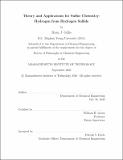| dc.contributor.advisor | William H. Green. | en_US |
| dc.contributor.author | Gillis, Ryan J.(Ryan Joseph) | en_US |
| dc.contributor.other | Massachusetts Institute of Technology. Department of Chemical Engineering. | en_US |
| dc.date.accessioned | 2021-05-14T16:33:30Z | |
| dc.date.available | 2021-05-14T16:33:30Z | |
| dc.date.issued | 2020 | en_US |
| dc.identifier.uri | https://hdl.handle.net/1721.1/130618 | |
| dc.description | Thesis: Ph. D., Massachusetts Institute of Technology, Department of Chemical Engineering, September, 2020 | en_US |
| dc.description | Cataloged from the official PDF of thesis. | en_US |
| dc.description | Includes bibliographical references (pages 231-244). | en_US |
| dc.description.abstract | In this thesis, I explore the chemistry of reacting sulfur species computationally and experimentally. The computational work centers around creating the capability to automatically predict the thermochemical properties of arbitrary sulfur molecules and the kinetic parameters of reactions between these species. A demonstration of this enhanced capability is shown in the automatic creation of detailed chemical mechanism describing the partial oxidation of dimethyl sulfide. The experimental work focuses on a hydrogen generating chemical cycle that uses a hydrogen sulfide feed-stock. Initially exploring the reactivity of hydrogen sulfide, water, and iodine mixtures to form hydroiodic acid, two competing pathways were discovered. The more interesting pathway involved the reaction of hydrogen sulfide with iodine and water to form hydroiodic acid and sulfur dioxide. A bench-top prototype was created demonstrating the creation of hydrogen gas from hydrogen sulfide through this pathway. Technoeconomic modeling of the proposed process was conducted, suggesting both commercial and environmental motivation for adoption. The thesis concludes with a brief discussion of future work. | en_US |
| dc.description.statementofresponsibility | by Ryan J. Gillis. | en_US |
| dc.format.extent | 244 pages | en_US |
| dc.language.iso | eng | en_US |
| dc.publisher | Massachusetts Institute of Technology | en_US |
| dc.rights | MIT theses may be protected by copyright. Please reuse MIT thesis content according to the MIT Libraries Permissions Policy, which is available through the URL provided. | en_US |
| dc.rights.uri | http://dspace.mit.edu/handle/1721.1/7582 | en_US |
| dc.subject | Chemical Engineering. | en_US |
| dc.title | Theory and applications for sulfur chemistry : hydrogen from hydrogen sulfide | en_US |
| dc.type | Thesis | en_US |
| dc.description.degree | Ph. D. | en_US |
| dc.contributor.department | Massachusetts Institute of Technology. Department of Chemical Engineering | en_US |
| dc.identifier.oclc | 1249634205 | en_US |
| dc.description.collection | Ph.D. Massachusetts Institute of Technology, Department of Chemical Engineering | en_US |
| dspace.imported | 2021-05-14T16:33:30Z | en_US |
| mit.thesis.degree | Doctoral | en_US |
| mit.thesis.department | ChemEng | en_US |
